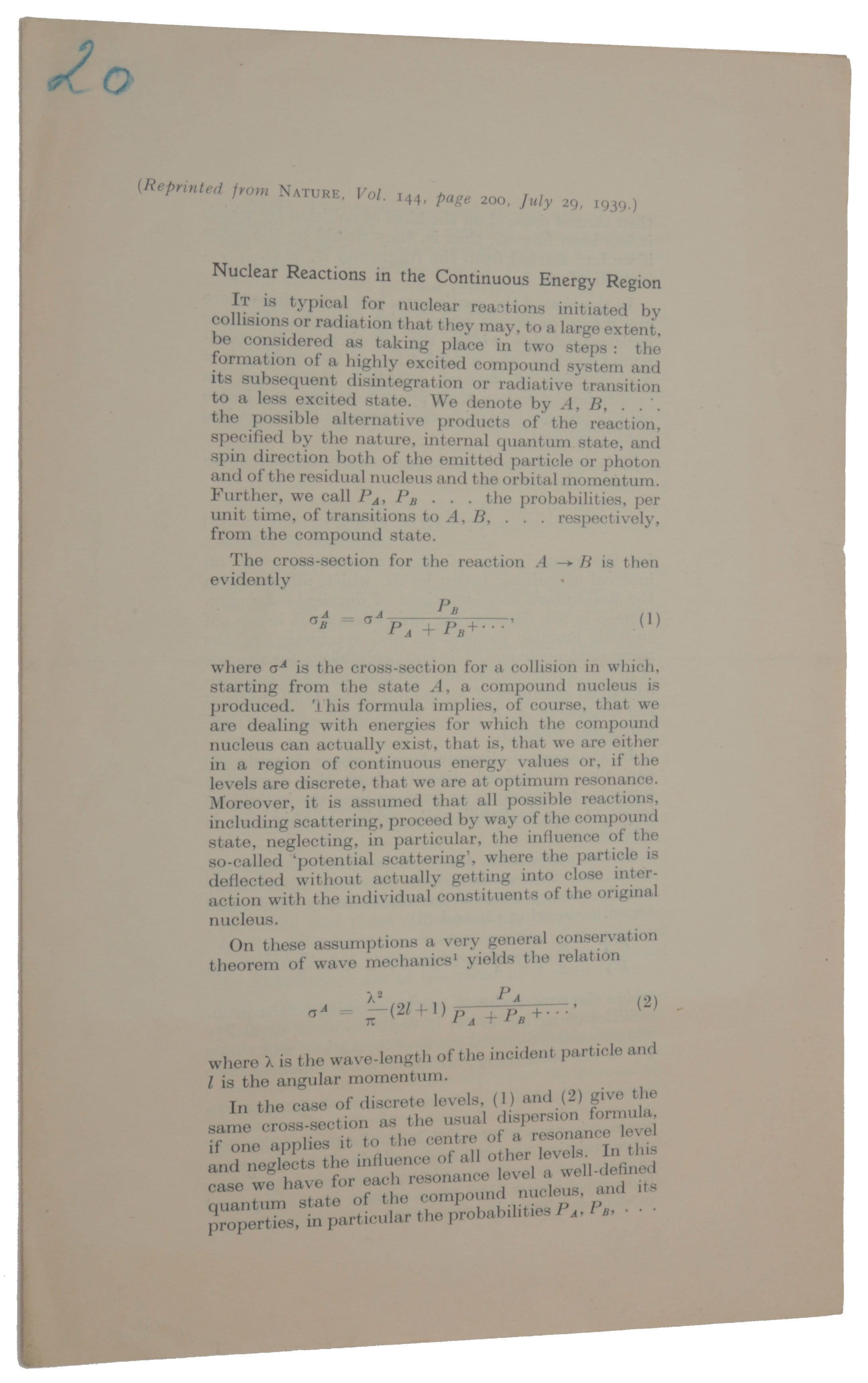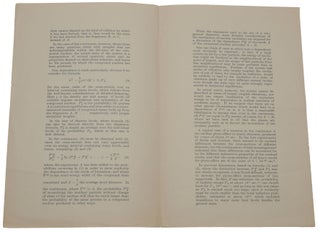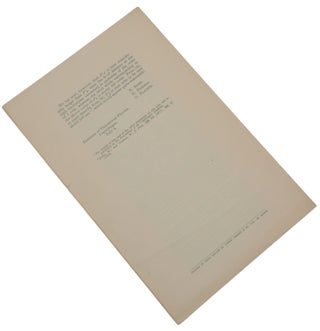Nuclear reactions in the continuous energy region. Offprint from Nature, Vol. 144, July 29, 1939.
[London: Macmillan, 1939]. First edition, very rare offprint, of this sequel to the paper of Bohr & Kalckar, ‘On the Transmutation of Atomic Nuclei by Impact of Material Particles’, which had introduced the ‘liquid-drop model’ of the nucleus. “Bohr’s ‘droplet model’ of nuclear reactions, refined in various ways since it was proposed in 1936, still holds as the adequate mode of description of one of the most important types of nuclear processes” (DSB). “In 1938 [Bohr] began a collaboration with Rudolph Peierls and George Placzek on an improved general treatment of nuclear reactions at higher energies (denser levels). Preliminary results were published in 1939 [in the offered paper]. Plans for a longer paper, interrupted by the war and taken up again thereafter, were never executed. ‘Copies of some drafts circulated during [the war years] and as a result the paper was cited repeatedly in the literature, making it one of the most cited unpublished papers’” (Pais, Niels Bohr’s Times, p. 341). In the present paper, the authors study the impact of neutrons of sufficiently high energy on medium and heavy nuclei, and the probability (or ‘cross-section’) for the temporary capture of a neutron by a nucleus. One of its most important contributions was to establish a quantum mechanical version of the ‘optical theorem,’ a general law relating the forward scattering amplitude to the cross section of the scatterer. “Using the optical theorem and Bohr’s liquid-drop model of the nucleus, Placzek, Bohr, and Peierls offered a fundamental theory of neutron-induced nuclear reactions. These works proved essential to the subsequent development of nuclear theory and to development of nuclear reactor design” (DSB, under Placzek). Bohr, Peierls, and Placzek drafted and redrafted a detailed paper many times. In June 1939 Bohr wrote to Peierls that “‘Placzek suggested it would be nice if a short account of the result could appear in Nature in the near future, and I shall bring with me a draft Placzek and I have written’ … This draft, after minimal polishing, was published in the July 29, 1939 issue of Nature” (George Placzek: A Nuclear Physicist's Odyssey, p. 31). It carries the following footnote: “The details of this and of the other arguments of this note will be published in the Proceedings of the Copenhagen Academy.” But in fact no detailed version of this paper ever appeared. No other copy listed on ABPC/RBH. Not on OCLC. In the present paper, the authors study the impact of neutrons of sufficiently high energy on medium and heavy nuclei, and the probability (or ‘cross-section’) for the temporary capture of a neutron by a nucleus. One of its most important contributions was to establish a quantum mechanical version of the ‘optical theorem,’ a general law relating the forward scattering amplitude to the cross section of the scatterer. In classical physics, the optical theorem was first derived by Lord Rayleigh in the context of scattering and absorption of light (he used it to explain why the sky is blue). In the present case it applies to the scattering of neutrons by heavy nuclei. It is of very general applicability as it depends only on conservation of energy (in the classical case) or conservation of probability (in the quantum mechanical case). The optical theorem is still often called the Bohr-Peierls-Placzek relation. The emergence of the optical theorem in the problem of quantum scattering came as an unexpected surprise. The optical theorem now appears in all advanced textbooks of quantum mechanics, although its authors, Bohr, Peierls, and Placzek, are rarely mentioned. In addition to the optical theorem, this paper also addresses a fundamental difficulty that occurs when one is concerned with the region of continuous energy. “The general theory of resonance processes [those which occur preferentially at or near particular impact energies], first derived by Breit and Wigner for the case of a single resonance level, was at first applied also to the case in which the width of the resonance levels is greater than their spacing, so that at any energy a number of levels contribute. On the other hand one can derive the cross section for the formation of a compound nucleus by the capture of a particle from the general theorem of detailed balancing in terms of the decay constant, i.e., the probability of escape of the same particle from the compound nucleus. As long as the levels do not overlap, the two methods give the same answer, but in the case of overlapping levels, they differ… This discrepancy had already been noticed by Kalckar, Oppenheimer and Serber, who concluded that the result obtained from the extension of the Breit-Wigner formula was the correct one … The conclusion of Bohr, Peierls and Placzek, summarized in [the present letter], was that, in fact, the answer from the detailed balancing argument was the right one. The failure of the other result was due to the fact that, in the case of overlapping levels, the state of the compound nucleus is not uniquely defined by its energy … “Bohr read a paper to the [Copenhagen] Academy on 21 October 1938, of which only an abstract is available, which describes this talk as “in connexion with the communication of a paper, written in collaboration with G. Placzek and R. Peierls”. No such joint paper was available at the time, but perhaps Bohr reported in his talk the stage which the discussions and partial drafting of a paper had reached. The published abstract is not sufficiently detailed to indicate this. “The drafting of a paper, which was meant to be a sequel to the Bohr-Kalckar paper, had in fact been underway since the spring of 1938. The difficulties in trying to arrive at an agreed draft were mostly concerned with presentation, rather than substance. Peierls and Placzek were anxious to base the arguments on a complete theoretical foundation … Bohr found these calculations rather complicated and formal. He tried to use more intuitive arguments which the others in turn did not find convincing … “Because of the slow progress it was suggested that a short note for Nature be prepared: ‘On my next visit I should be very happy if we could work [for] a few days together on a brief note to ‘Nature’ about the main results of our common work on the nuclear dispersion theory … Due to the unquiet times and my unavoidable occupation with the fission problem I regret that I have not yet found opportunity to finish our article with Placzek but, as Placzek suggested, it would be nice if a short account of the results could appear in ‘Nature’ in the near future, and I shall bring with me a draft Placzek and I have written’ [Bohr to Peierls, 6 June, 1939]” (Peierls (ed.), Niels Bohr: Collected Works, Vol. 9, Nuclear Physics (1929-1952), pp. 48-50).
4to (215 x 140 mm), pp. 200-201. Single sheet, without binding, as issued. The number ‘20’ written in blue crayon in upper right corner of first page.
Item #5036
Price: $2,000.00




